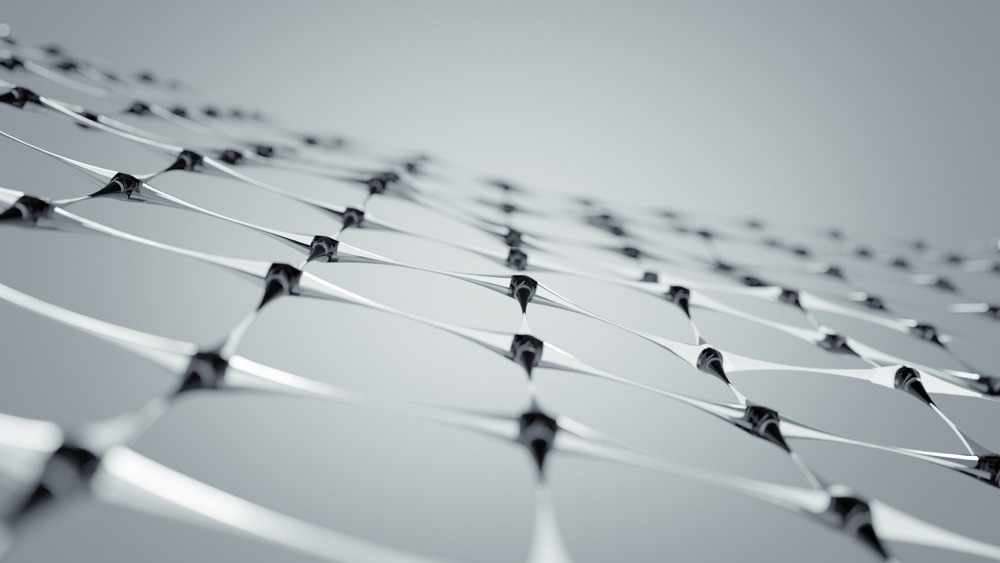Graphene, a single layer of carbon atoms arranged in a hexagonal lattice, has been the subject of intense scientific examination since its discovery due to its remarkable properties, including exceptional electrical conductivity, mechanical strength, and thermal conductivity.

Image Credit: gonin/Shutterstock.com
One method that has gained prominence in producing high-quality graphene is laser-scribed graphene (LSG). This article explores the process of LSG, its key components, and how it compares to other techniques like chemical vapor deposition (CVD).
What is Laser-Scribed Graphene
Laser-scribed graphene is a versatile technique that involves the use of a high-power laser to directly pattern and reduce graphene oxide (GO) films into graphene structures under ambient conditions and requires minimal post-treatment, making it an attractive option for large-scale graphene production.
Laser-Scribing Process
The process begins with the preparation of graphene oxide, typically derived from graphite, using well-established oxidation methods. After that, the next step involves depositing a uniform layer of graphene oxide onto a substrate through various methods, including spin coating, drop casting, or spray coating. The choice of substrate depends on the intended application of the LSG material.
After depositing a uniform layer, the most important step, Laser Scribing, is done via a high-power laser precisely focused onto the graphene oxide film. This laser's energy is absorbed by the GO, which triggers a series of chemical and physical processes, including reducing graphene oxide to graphene, removing oxygen functional groups, and creating microscale or nanoscale patterns on the film.
The laser is controlled to create specific patterns on the graphene oxide film, which determine the final shape and design of the graphene structures. This ability to tailor the pattern provides flexibility in designing graphene-based devices for various applications.
After that, depending on the desired properties, the LSG material may undergo post-treatment processes such as annealing or chemical reduction to improve its electrical and structural characteristics further.
Key Components of LSG
Several key components play a crucial role in the successful implementation of laser-scribed graphene. For instance, a high-power laser source with precise control over energy and focus is essential. Carbon dioxide (CO2) lasers and neodymium-doped yttrium aluminum garnet (Nd: YAG) lasers are commonly used for this purpose. High-quality graphene oxide as the starting material for LSG significantly influences the final graphene product.
Similarly, the choice of substrate depends on the application but should be compatible with both the graphene oxide deposition method and the laser scribing process. Finally, an advanced control system is necessary to control the laser's power, focus, and movement precisely to achieve the desired patterns and properties in the LSG material.
Comparing LSG to CVD
Chemical vapor deposition (CVD) offers a practical method for creating high-quality, extensive graphene films. This process involves heating a carbon-rich source until it breaks down and allowing the resulting carbon atoms to arrange themselves in a honeycomb pattern atop a metallic catalyst film.
LSG is inherently scalable, as it can be performed on large substrates, making it suitable for industrial applications. Moreover, LSG is a one-step process that can be performed at room temperature and atmospheric pressure, whereas CVD requires a controlled environment with high temperatures and specific gas mixtures, making it more complex and expensive. Patterning with CVD is quite challenging compared to LSG since LSG excels in precision patterning, allowing for the creation of intricate designs that provide higher-quality graphene in terms of electronic properties.
CVD-grown graphene often requires additional processing steps, such as transfer onto a target substrate and annealing, to improve its properties compared to LSG. Finally, LSG is a more environmentally friendly choice due to its ambient conditions and reduced energy requirements.
Applications of Laser-Scribed Graphene
Laser-scribed graphene finds applications across a wide range of fields, including electronics, sensors, composites and more. LSG is used to fabricate flexible and transparent conductive films, electrodes, and interconnects for electronic devices like flexible displays, touchscreens, and wearable electronics.
Graphene-based supercapacitors and batteries benefit from LSG's ability to create intricate electrode designs with high surface area, leading to improved energy storage and faster charge-discharge rates, potentially revolutionizing energy storage solutions.
Similarly, the precision patterning capabilities of LSG make it ideal for creating gas sensors, biosensors, and chemical sensors with tailored sensitivity and selectivity. Moreover, LSG can be incorporated into composites to enhance their mechanical and electrical properties and have applications in the aerospace, automotive, and construction industries.
Future Prospects
The future of LSG holds promise as researchers explore novel applications and seek to overcome existing limitations. Advancements in laser technology, graphene oxide synthesis, and post-processing techniques are expected to drive further innovation in this field.
In conclusion, laser-scribed graphene is a powerful and versatile technique for producing high-quality graphene structures with precision patterning. Its ease of production, cost-effectiveness, and suitability for various applications make it a valuable tool in the graphene materials toolbox and a game-changer in graphene production, opening new possibilities for diverse applications.
References and Further Reading
Ameku, W. A., et al. (2022). Laser-Scribed Graphene-Based Electrochemical Sensors: A Review. Chemosensors. doi.org/10.3390/chemosensors10120505
Kataria, S., et al. (2014). Chemical vapor deposited graphene: From synthesis to applications. physica status solidi. doi.org/10.1002/pssa.201400049
Nayak, P., et al. (2016). Highly efficient laser scribed graphene electrodes for on‐chip electrochemical sensing applications. Advanced Electronic Materials. doi.org/10.1002/aelm.201600185
Strong, V., et al. (2012). Patterning and electronic tuning of laser scribed graphene for flexible all-carbon devices. ACS nano. doi.org/10.1021/nn204200w
Wan, Z., et al. (2021). Laser scribed graphene for supercapacitors. Opto-Electronic Advances. doi.org/10.29026/oea.2021.200079
Disclaimer: The views expressed here are those of the author expressed in their private capacity and do not necessarily represent the views of AZoM.com Limited T/A AZoNetwork the owner and operator of this website. This disclaimer forms part of the Terms and conditions of use of this website.